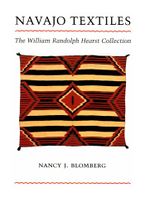Difference between revisions of "WikiRug:Book of the week/2020/53"
Jump to navigation
Jump to search
(Created page with "<!--Book Cover Image--> right|150px <!--Book Title & Author--> <div style= "font-size:85%;text-align:center;"> '''''N...") |
|||
| Line 10: | Line 10: | ||
</div> | </div> | ||
<!--Book Description--> | <!--Book Description--> | ||
| − | ''[[Navajo Textiles: The William Randolph Hearst Collection]]'', create by Nancy J. Blomberg. William Randolph Hearst's collection of Navajo textiles is one of the most complete gatherings of nineteenth-century Navajo weaving in the world. Comprising dozens of Classic Period serapes, chief blankets, Germantown eyedazzlers, and turn-of-the-century rugs, the 185-piece collection was donated to the Los Angeles County Museum of Natural History in 1942 but for the next forty years was known only to a handful of scholars. Hearst began acquiring textiles from the Fred Harvey Company after viewing an exhibit of Indian artifacts | + | ''[[Navajo Textiles: The William Randolph Hearst Collection]]'', create by Nancy J. Blomberg. William Randolph Hearst's collection of Navajo textiles is one of the most complete gatherings of nineteenth-century Navajo weaving in the world. Comprising dozens of Classic Period serapes, chief blankets, Germantown eyedazzlers, and turn-of-the-century rugs, the 185-piece collection was donated to the Los Angeles County Museum of Natural History in 1942 but for the next forty years was known only to a handful of scholars. Hearst began acquiring textiles from the Fred Harvey Company after viewing an exhibit of Indian artifacts. |
| − | |||
| − | |||
Latest revision as of 12:29, 17 December 2020
Navajo Textiles: The William Randolph Hearst Collection
'Author: Nancy J. Blomberg
Navajo Textiles: The William Randolph Hearst Collection, create by Nancy J. Blomberg. William Randolph Hearst's collection of Navajo textiles is one of the most complete gatherings of nineteenth-century Navajo weaving in the world. Comprising dozens of Classic Period serapes, chief blankets, Germantown eyedazzlers, and turn-of-the-century rugs, the 185-piece collection was donated to the Los Angeles County Museum of Natural History in 1942 but for the next forty years was known only to a handful of scholars. Hearst began acquiring textiles from the Fred Harvey Company after viewing an exhibit of Indian artifacts.
